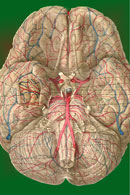|
|
 |
CEREBRAL BLOOD FLOW AUTOREGULATION
Adequate cerebral blood flow (CBF) must be maintained at all
times in order to ensure the delivery of sufficient O2
and glucose to the brain. Fortunately we have automatic
regulating systems which ensure adequate flow. The cerebral
arterial vasculature is in a normal state of partial
constriction and the CBF can be increased by vasodilation, which
decreases cerebrovascular resistance. Likewise, increased
vasoconstriction causes the cerebrovascular resistance to
increase, producing a corresponding decrease in cerebral blood
flow. Changes in cerebrovascular resistance and hence cerebral
blood flow are caused by (1) fluctuations in perfusion pressure
and (2) variations in circulating Po2, and Pco2.
 |
Changes in Perfusion Pressure
If we subtract intracranial pressure (ICP) from the mean
arterial pressure (MAP), we obtain the effective
perfusion pressure (PP) in the brain. Within
physiological limits, changes in PP feed back negatively
to change cerebrovascular resistance, thus maintaining a
constant CBF. If the PP decreases, the expected drop in
CBF is not realized because the automatic compensatory
decrease in cerebrovascular resistance maintains blood
flow near normal limits. Similarly, an increase in PP
doesn't produce an increase in CBF because compensatory
increases in cerebrovascular resistance again maintain
the CBF at normal levels.
This auto regulating compensatory mechanism operates
within the PP range of 50 to 180 mmHg. Since the
cerebral vessels have presumably dilated maximally when
the PP drops to 50 mmHg, further drops in pressure can't
be compensated for, and CBF begins to fall accordingly
(Fig. 17-4). Likewise, once the PP increases to around
180 mmHg, the vessels are maximally vasoconstricted and
cannot compensate for further increases in pressure.
Thus beyond 180 mmHg the cerebral blood flow rises
directly with the perfusion pressure.
|
 |
Changes in PO2 and PCO2
Decreases in arterial P02 produce no change
in cerebrovascular resistance until the level falls to
approximately 50 mmHg. Below this level we see
vasodilation and an increase in CBF. When the P02
drops to 30 mmHg, the CBF reaches a level about 50
percent greater than normal. Increases in P02
above the normal level of 96 mmHg cause a slight
increase in cerebrovascular resistance and a subsequent
drop in CBF. It is interesting to note that the
compensatory rise in CBF caused by falling O2
levels is greater than the drop in CBF caused by higher
than normal O2 levels, once again stressing
the importance the body puts on supplying adequate O2
to the brain.
Increases in arterial Pco, profoundly increase the CBF.
Blood flow to the brain can be almost doubled by
breathing 7 percent CO2,
Conversely, hyperventilating can reduce the arterial
Pco, sufficiently to drop the CBF from its normal 55 mL
per 100 g per minute to 34 mL per 100 g per minute. It
is not surprising to find that dizziness often occurs at
this level when you consider that unconsciousness
appears at 30 mL per 100 g per minute.
Because pH is profoundly influenced by Pco., through the
reaction of CO2 with H20 to form H2C03
in the presence of the enzyme carbonic anhydrase, there
has been some question as to whether the changes in
vasomotor tone are due to CO2 or Hrions.
Studies in which carbonic anhydrase has been poisoned by
acetazolamide show that the normal effects of altered
Pco, on vasomotor tone are eliminated. This would
suggest that CO2 plays only an indirect role
while it is actually the change in H + -ion
concentration which is the directly acting agent.
Further, since the application of acid to the cortex
causes no vascular change nor do H+ ions freely enter
cells while CO2 does, it is likely that
intracellular rather than extracellular H+ ions are
involved. |
|
 |
 |
|
Our brain is a mystery and to understand it, you
need to be a neurosurgeon, neuroanatomist and neurophysiologist.

neurosurgery.tv

Please visit this site, where daily neurosurgical activities are going
on.

Inomed ISIS IOM System
|
|
|
|



